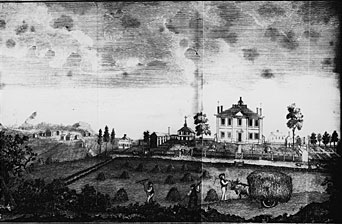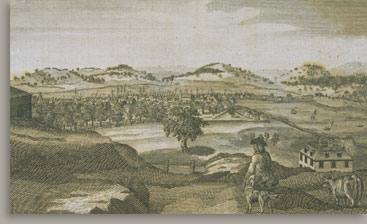Description The middle distance at left includes a group of four houses and two steeples in a line that is continued by a road that emerges from the tree line and winds toward another public building of some sort and at least seven more houses. The densely wooded area between the two steeples is beginning to show autumn foliage. The middle distance in the center of the painting is further divided by stone walls and woods and contains grazing sheep and cows. Farmhouses, fenced fields in varying shades of green, and alternately open and wooded land continue on the right side of the painting. The horizon is similarly divided into farms and woods. A second road forms a short diagonal at about one-third the width of the painting from the left edge, along which are several houses and a large, probably public, building. This image of rural and village life continues across the horizon and is punctuated by a white building that appears to be a church, just inside the large, framing tree on the right side. In all, the painting includes at least sixty-five structures, including meetinghouses, dwellings, and outbuildings. Biography Thomas Denny’s prominence in Leicester may be measured not only by his landholdings but also by the many public offices to which he was elected. He served as town clerk, selectman, moderator of the selectmen, town representative in the General Court of Massachusetts, justice of the peace, and tax assessor. Denny also served Leicester as Fence Viewer, Hogg Constable, and Surveyor of the Highways, and he represented it in a communal ritual called "perambulations," in which selectmen from two adjoining towns met to affirm the boundaries.3 In the fall of 1786 and spring of 1787, Denny commanded a cavalry unit that helped to suppress Shays’ Rebellion in Worcester. Although many were sympathetic to charges that the commonwealth lacked sufficient circulating currency, that heavy taxation imposed an undue burden, and that government officials in Boston were extravagant and removed from the lives of their constituents, Denny and leaders in other central Massachusetts towns acted together to prevent protestors from closing the courts. He was rewarded for his role in helping put down the rebellion with the rank of captain in the militia and was later made a colonel.4 Denny commissioned this painting shortly after moving from the family farm into Leicester proper and establishing himself there as a retailer of textiles, books, and household goods and as a card-clothing manufacturer. (Card clothing consists of a strip of perforated leather through which thin pieces of wire are drawn; this tool was then used to card wool and cotton fibers.) Card-clothing manufacture was among the first major steps taken toward development of Massachusetts’s textile industry. By the time he died, in 1814, Thomas Denny had considerable commercial and industrial holdings both in Leicester and in Ware, in neighboring Hampshire County.5 Analysis Although Earl did not paint pure landscapes until the last five years of his life, landscape was one of his main means of establishing the identities of his sitters in portraits he produced from 1783 on. He painted several images of gentleman hunters out-of-doors, including Portrait of a Man with a Gun. Also, like many other painters of that time, Earl often placed a sitter indoors near an open window, through which is visible some representative portion of the sitter’s estate. For instance, in Thomas Earle (fig. 1), a likeness of the painter’s cousin, the window opens onto a view of the subject’s house and gunsmith shop.7 This work was painted during the same visit to Earl’s native Leicester during which he created Looking East from Denny Hill. Earl depicted the landscape from the vantage point of the farmhouse—sited at 950 feet above sea level—where Daniel Denny had established the family in 1717 and where his grandson Thomas Denny lived until about 1795. Anna Henshaw (1778–1854), a Denny cousin, wrote a description of the vista at about the time Earl painted it:
Henshaw’s description encompasses views to the northwest and northeast; Earl’s painting takes in the Denny farm and the scenery east of it. It is readily apparent that the Dennys and their neighbors have improved the land, partitioned it with trees, fences, and walls, and cultivated productive fields. In these features, the painting embodies the agrarian ideal described by such prominent early Americans as Yale president Timothy Dwight, who visited Worcester in the 1790s and observed: "A farm well surrounded and divided by good stone walls presents to my mind, irresistably [sic], the image of tidy, skillful, profitable agriculture, and promises me within doors the still more agreeable prospect of plenty and prosperity."9
The composition may be understood best in relation to two types of landscapes commonly engraved for popular American magazines in the 1780s and 1790s: estate views and prospect views. The former is exemplified by Samuel Hill’s View of the Seat of the Hon. Moses Gill . . . , (fig. 2). Estate views derive from the tradition of English prints of country houses. In such prints, the vantage point is typically low and takes in a stately house and the land immediately in front of it. Gardens, outbuildings, ornamental fences, and other improvements were signs of the individual’s worthiness to possess the land and of his contribution to the general good, as the text accompanying the Hill print in Massachusetts Magazine indicates:
Earl’s understanding of this landscape model is seen in paintings such as Houses Fronting New Milford Green.
This pictorial and poetic definition of balanced land use—often defined in that period with manufacturing as an essential third component—was considered requisite to economic harmony and a self-sustaining republic. The juxtaposition of agricultural Leicester and commercial Worcester in Earl’s painting echoes the theme of economic balance articulated in Samuel Hill’s prospect view of Boston. The choice of this compositional model for Earl’s Looking East from Denny Hill is therefore especially interesting. The painting shares with estate views a visual inventory of Thomas Denny’s landholdings, but it moves out toward the community rather than inward to the patron’s house. This emphasis suggests that Earl—probably with Denny’s approval and perhaps at his request—sought to link his patron to prevailing attitudes about what constituted enlightened citizenship during the early years of the American republic. The effect was to present Denny as a civic-minded landowner, not one working solely for personal aggrandizement. Notes 2. "A List of the Polls and of the Estates, Real and Personal, of the Several Proprietors and Inhabitants of the Town of Leicester . . ." Massachusetts General Court, Valuation Lists, Leicester, 1784, box 380, Massachusetts State Library, Boston. 3. For the public offices Denny held, see Washburn, 1860, 34, 63, 195, 459–60; and General Records, 1745–1787: Town of Leicester and General Records, 1787–1829: Town of Leicester, Leicester Town Hall. 4. General Records, 1745–1787: Town of Leicester, September 25, 1786, 442–43, and May 25, 1787, 8. Until Shays’ Rebellion, Thomas Denny is listed as "Mr." in the town records. But in 1788, the year following the rebellion, he appears as "Capt." and in 1791 as "Colonel." General Records, 1745–1787: Town of Leicester, September 25, 1786, 442, and General Records, 1787–1829: Town of Leicester, March 3, 1788, 14, and May 9, 1791, 55. 5. Thomas Denny, probate inventory, Registry of Probate, Worcester County Court House, Worcester, Mass., record 16654. 6. These landscapes are published in Kornhauser 1991a, 206–7 (Ruggles Homestead), 208 and 210–11 (Canfield House), 217–18 (New Milford Green), 226–28 (Old Bennington). 7. Cynthia J. Mills, in Miles 1995. The Worcester Art Museum purchased the Thomas Earle portrait in 1916 but deaccessioned it in 1921. 8. Anna Henshaw, handwritten copy of a manuscript, about 1800, object file, Worcester Art Museum. 9. Dwight, as quoted in Brooke 1989, 2. 10. Ruth Henshaw Bascom, a Leicester woman, recorded buying trips that members of her family made to Leicester, Worcester, and Boston. See, for example, diary entries: May 22, 1799, to Boston; November 6, 1799, to Worcester; and November 11, 1799, to Thomas Denny’s store in Leicester. Manuscript, American Antiquarian Society, Worcester, Mass. 11. St. George 1998, 342. 12. Dresser 1945, 205, 207. 13. Izard 1993, 65. 14. "Description of the Plate," Massachusetts Magazine 4: 11 (November 1792): [651]. 15. "Description of the Plate," Massachusetts Magazine 2: 11 (November 1790): [643].
|



